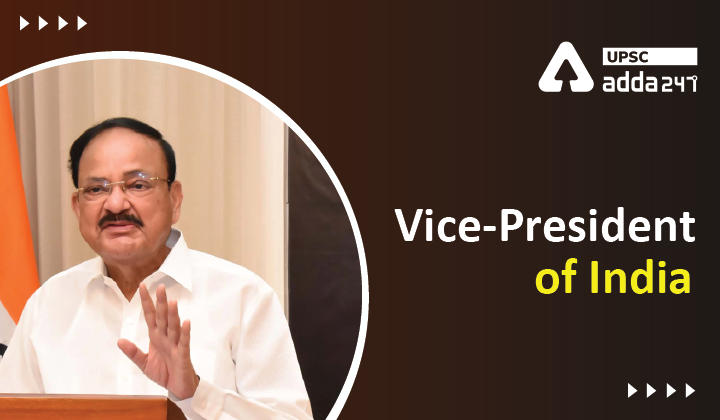Table of Contents
Vice-President of India- Relevance for UPSC Exam
- GS Paper 2: Indian Constitution- Historical underpinnings, evolution, features, amendments, significant provisions and basic structure.
Vice-President of India
- Constitutional Provisions: The Office of the Vice-President of India is mentioned in Part V of the Constitution of India under Chapter I (Executive).
- Article 63 of the Indian Constitution mentions the post of Vice-President.
- The Constitutional Articles from 63-73 deal with the qualifications, election and removal of the Vice-President of India.
- Constitutional Status: The Vice-President of India is the second-highest constitutional office in the country.
- Present Vice-President: Muppavarapu Venkaiah Naidu is the current Vice President of India and the Chairman of the Rajya Sabha.
Qualifications for the election of Vice-President
- The Vice-President shall not be a member of either House of Parliament or of a House of the Legislature of any State.
- If a member of either House of Parliament or of a House of the Legislature of any State be elected Vice-President, he shall be deemed to have vacated his seat in that House on the date on which he enters upon his office as Vice-President.
- No person shall be eligible for election as Vice-President unless he –
- is a citizen of India;
- has completed the age of thirty-five years; and
- is qualified for election as a member of the Council of States.
- A person shall not be eligible for election as Vice-President if he holds any office of profit under-
- The Government of India or
- The Government of any State or
- Any local or other authority subject to the control of any of the said Governments.
- Note: For the purposes of this article, a person shall not be deemed to hold any office of profit by reason only that he is the President or Vice-President of the Union or the Governor of any State or is a Minister either for the Union or for any State.
Election of Vice-President of India
- Eligible Voters: The Vice-President shall be elected by the members of an electoral college consisting of the members of both Houses of Parliament.
- Note: Both elected and nominated members of the parliament (Lok Sabha and Rajya Sabha) participates in the election of Vice-president.
- Election Method: The election of the Vice-President of India is held in accordance with the system of proportional representation by means of a single transferable vote.
- The voting in the Election of the Vice-President of India shall be by secret ballot.
Constitutional Articles relating to Vice-President of India
| Vice Presidents of India [Article 63 to Article 71] | |
| Article 63 | There shall be a Vice President of India |
| Article 64 | The Vice-President shall be ex-officio Chairman of the Council of States and shall not hold any other office of profit |
| Article 65 | The Vice-President to act as President or to discharge his functions during casual vacancies in the office, or during the absence, of President |
| Article 66 | The Vice-President shall be elected by the members of an electoral college consisting of the members of both Houses of Parliament. The Vice-President shall not be a member of either House of Parliament or of a House of the Legislature of any State. |
| Article 67 | The Vice-President shall hold office for a term of five years from the date of his appointment. |
| Article 68 | An election to fill a vacancy created because of the completion of the term of office of Vice-President shall be completed before the expiry of the term.
The election to fill a vacancy created because of the death, resignation or removal of the Vice-President shall be held as soon as possible. |
| Article 69 | Every Vice-President shall make an Oath or Affirmation on entering upon his office before the President, or some person appointed in that behalf by him |
| Article 70 | Discharge of President’s functions in other contingencies |
| Article 71 | Matters relating to, or connected with, the election of a president or vice-president |
Vacancy and Impeachment of The President
President of India | Key Functions and Powers of President





 TSPSC Group 1 Question Paper 2024, Downl...
TSPSC Group 1 Question Paper 2024, Downl...
 TSPSC Group 1 Answer key 2024 Out, Downl...
TSPSC Group 1 Answer key 2024 Out, Downl...
 UPSC Prelims 2024 Question Paper, Downlo...
UPSC Prelims 2024 Question Paper, Downlo...




